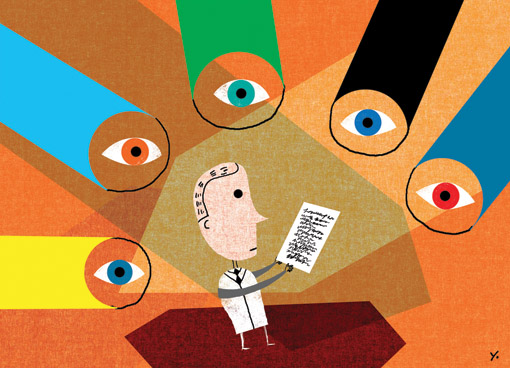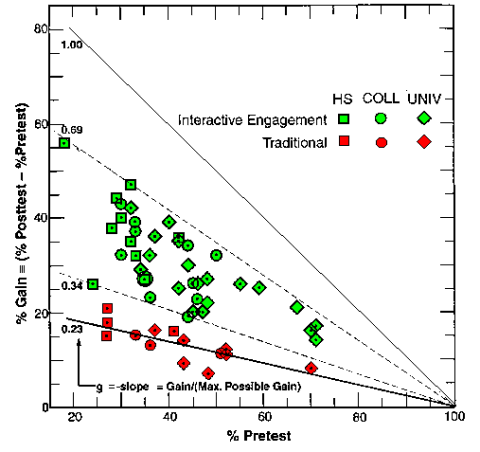Kodic, Leanne
Learning activity design in relation to using peers

"peer discussion enhances understanding, even when none of the students in a discussion group
originally knows the correct answer" Smith et al (2009)
Contents
- What makes a good teacher?
- “Reciprocal Peer Critiquing”
* Particularly important points are highlighted in bold, showing the main information which should be taken away from this page.
What makes a good teacher?
To be a ‘good’ teacher, it is argued that you have to be good across a number of different areas, with the three main ones being:
- Delivery , or the way you choose to teach students e.g. the choice of formal lectures or informal discussion based seminars
- Creating knowledge , or the selection of particular topics and materials which you feel will be the most beneficial for the students
- Designing learning activities , or creating teaching strategies which show marked results in the students learning
This page is going to look specifically at the third role in order to see if students can show marked improvement in their studies by teachers inventing and using new methods and styles of teaching.
A starting reference…
Hake, R. R. (1998) "Interactive-engagement versus traditional methods: A six thousand student survey of mechanics test data for introductory physics courses" American Journal of Physics , 66(1), 64-74.
Hake (1998) “Interactive Engagement”
- Hake used 6,542 Physics students across 62 courses who did the same standardised test before and after the test period
- Some followed interactive engagement teaching methods, described as ‘ those designed at least in part to promote conceptual understanding through interactive engagement of students in heads-on (always) and hands-on (usually) activities which yield immediate feedback through discussion with peers and/or instructors’
- Some followed traditional courses, described as ‘those which make little or no use of interactive engagement methods, relying primarily on passive-student lectures, recipe labs, and algorithmic-problem exams’

- This graph shows the results obtained, which were plotted using the result from the pre-test against the percentage gained. It was done this way in order to only show the effects that the teaching method itself added i.e. if they knew 50% of the content before, and now know 75%; they have had a gain of 0.5 through the method used. The diagonal trend lines on the graph suggest that everyone has shown some improvement, however it is much less in the ones who had more knowledge to begin with. Although most students gained at least something from both of the courses, it is obvious that those who participated in interactive engagement all did better than those following traditional teaching methods.
- In fact, those following traditional methods had an average gain of 0.23 ± 0.04 (std dev) compared with those doing interactive engagement who showed an average gain of 0.48 ± 0.14 (std dev) which is an improvement of almost 2 standard deviations.
Crouch & Mazur (2001) “Peer Instruction”
- Another version of interactive engagement was analysed over a period of 10 years by Crouch and Mazur. This method involved brain teaser questions and discussion to provoke debate between peers. In this method, if a particular question splits the class opinion, peers are encouraged to discuss their reasoning as to why they believe something different to someone else, until eventually one argument is chosen and it is resolved.
- The main reason it works is because the struggle to generate reasons for your own thoughts challenges your own understanding, and debating lets you experience someone else’s views. This may help to consolidate your own.

- On this graph by Crouch and Mazur, the open bars represent normalised gain in traditionally taught courses, compared with the filled bars representing courses taught with peer instruction. Originally, it was estimated that this method will double the amount of learning; in fact it has nearly tripled the calculus-based content, and showed a substantial increase in algebra-based content also.
Draper (2007) “Reciprocal Peer Critiquing”
- Draper introduced this technique into Psychology tutorial groups of about 6 to 8 in order to obtain critical feedback on written work from their peers. Students are encouraged to look at the positive and negative aspects of the document as well as saying what they think should have also been added to it. Students do not need to mark the documents because this is often unhelpful as they tend to be more lenient than if a tutor had marked it.
- A study by Gemmel & Draper (2008) tested if this approach actually worked by using 5 groups of subjects who wrote 3 passages of text with given titles. The groups were:
- 1) Write only - subjects wrote a passage but did not give or receive peer critique.
- 2) Read only - subjects wrote a passage then read 6 others
- 3) Receive critique - subjects wrote a passage then received feedback from one peer
- 4) Give critique - subjects wrote a passage then critiqued two more
- 5) Combination - subjects wrote a passage, read examples, critiqued two examples, and received feedback on their own work
- The specific group interventions were carried out in between each passage in order to test whether offering critique to someone else’s work will improve your own.

- This graph clearly shows that between passages 1 and 3, improvement was shown within all groups. However even group 1, the control group, showed improvement suggesting this may be due to practice effects
- Despite this graph showing improvements, overall a non-significant result was generated when the 5 groups were compared to one another, showing it is not necessarily a beneficial method. This suggests that peer critique may not necessarily always be the best choice of teaching technique in all situations.
Conclusion
It cannot be denied that real results have been generated using teaching methods involving peer interaction, however it is also obvious that this may not always be the most successful way of helping students to learn as much as possible. The two examples mentioned above from Hake (1998) and Crouch and Mazur (2001) were based on physics courses, something in which questions usually have a definitive answer at the end. The interventions using peers were clearly successful in this case as the technique for getting to this answer has a clear path. However, when similar principles were applied to an essay based subject such as Psychology in Draper’s studies, it is not so successful. The reason for this may be that an essay is a very subjective piece of work with many ways of generating a very good answer. This means that what your peers believe works for them may not be right for yourself, therefore their feedback does not improve your own mark. However, despite this, peer interaction should still always be encouraged as it enables students to really understand and consolidate their own ideas in order to then be able to write a successful essay in the future based upon these.
Key References
Hake, R. R. (1998) "Interactive-engagement versus traditional methods: A six thousand student survey of mechanics test data for introductory physics courses" American Journal of Physics , 66(1), 64-74.
Crouch, C.H. & Mazur, E. (2001). Peer Instruction: Ten years of experience and results. American Journal of Physics, 69(9), 970-977.
Other References
Draper, S.W. (2007). Reciprocal Critiquing Exercise for Tutorials. http://www.psy.gla.ac.uk/~steve/resources/tactics/tutcr.html (accessed 20/03/12).
Gemmel, A & Draper, S.W. (2008). A study of Reciprocal Peer Critiquing. http://www.psy.gla.ac.uk/~steve/localed/docs/agemmell.pdf (accessed 20/03/12).
Smith, M.K., Wood, W.B., Adams, W.K., Wieman, C., Knight, J.K., Guild, N., & Su, T.T (2009). Why Peer Discussion Improves Student Performance on In-Class Concept Questions, Science, 323, 122-124.




